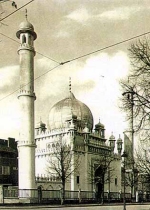Showing Islam is Peaceful • Tolerant • Rational • Inspiring
| Lahore
Ahmadiyya Home
|
Berlin
Mosque & Mission |
Reuter’s report on the re-opening of the Berlin Mosque under new Imam in 1949In The Light of 24 May 1949 on page 19, a report from Reuter’s Berlin correspondent is reproduced regarding the Berlin Mosque. The Light informs readers that this report was published in the Pakistan press under the headline: Spiritual Head of German Muslims. We reproduce this report below. Berlin, May I5. — More than 200 Berlin Muslims attended ceremony in Germany’s only Mosque — in the British sector of the city — last night to inaugurate Imam Mohd. {1} Aman Hobohm as spiritual head of all German Muslims. The inauguration was conducted by Professor Doctor Abdullah, Head of the European Muslim Centre, who was Imam of the German Muslims before the war. As an Indian national, he had to leave Germany when war broke out and the post remained vacant until yesterday. Berlin Muslims estimated at 220 comprising Egyptians, Arabs, Indians, Pakistanis, Iranians, Turks, Syrians, Yugoslavs and Germans. In an interview with the German News Agency, Professor Abdullah said he hoped closer relations would be established between the Berlin Mosque and the Muslim countries, particularly Pakistan. He said the blockade had severely handicapped the relief work done by Berlin Muslim.{2} Brief History of the Berlin MosqueThe foundation of the Berlin Mosque was laid in 1922 by Maulana Sadr-ud-Din who was deputed by the Ahmadiyya Anjuman Isha‘at Islam to deliver the message of Islam to the people of Germany. At the same time he laid the foundation of the Islamic Mission. Within a couple of years there stood in the heart of the German Capital, with all its grandeur and beauty, a huge building of the Berlin Mosque possessing a fascinating charm. A quarterly magazine in German under the title Muslimische Review was also started which rendered valuable services in disseminating the light of Islam in Central Europe. The strenuous work and the devoted efforts of the Islamic Mission attracted the attention of Germans, and by 1925 about forty people of high reputation embraced Islam. The opening ceremony of the mosque was attended by a large number of new converts to Islam as well as by a distinguished gathering of Muslims from Egypt, Syria, Persia, Afghanistan and India, including Allama Lufti, the leader of Muslims in Russia. In his inaugural speech, Allama Lufti said with a sense of pride that he had studied each and every word of the books of the Mujaddid recommended to him by Maulana Sadr-ud-Din and had found in them the light of truth in abundance which showed that he was in fact the Mujaddid of the time. Besides, Egyptians, Syrians, Iranians and Afghans delivered lectures and each of them expressed his love and appreciation for the mission. All Muslims were brought under one banner. Dr. Marcus, Dr. Griefelt and Dr. Banning were among the renowned personalities of the time who, realising the magnetic force of Islam, embraced it and devoted themselves to further the cause of Islam. Dr. Marcus’ personality needs no introduction. He is the man whose essays on the Holy Prophet, peace be upon him, left a deep impress upon the mind of Dr. Iqbal who, by way of compliment, observed: “Many a Muslim thinker and philosopher have written a great deal about the Holy Prophet, but none comes up to the mark of Dr. Marcus.” His way of presenting the Prophet is unmatched in its beauty, his force irresistible and his sincerity very convincing. Uptil 1938, the Muslim Mission’s work went on smoothly and uninterrupted, but with the outbreak of the war the whole thing was upset. A German doctor and his wife offered their services to Professor Dr. Abdullah to take care of the garden, the Mosque and the house adjacent to it. They decided also to bear themselves the expenses of running the mosque. Sometime later this doctor joined the army and was killed in action. His wife also left the place. A new convert to Islam, Frau Moslar, then came forward to take care of the mosque and the house. This magnificent Mosque was built at the cost of Rs. 150,000. During the war it served as a spiritual centre not only for hundreds of German converts to Islam but also for the thousands of other Muslims who were drawn to Berlin — Russians, Turks, Egyptians, Afghans, Indians and others. During the war, Muslim prisoners of war from India who happened to be in Germany also went to this Mosque for Id prayers. In the final stages of the war, when Berlin was attacked by the Russian forces, the Germans dug trenches in the Mosque garden and it, therefore, became a target for the invading forces. Though the Mosque survived the war, it suffered heavy damage. The dome itself was hit and damaged. One of the two minarets, 95 ft. high, was practically destroyed. Its repair cost the Anjuman more than eighty thousand Rupees. The Mosque is situated in the most fashionable locality of Berlin. Well laid out roads on its three sides with a foot path running side by side, lovely hedges and flower plants with a beautiful lawn in front add to the charm of the Mosque. Website Editor’s footnotes{1} Mohd. is a shorthand way of writing the name Muhammad. {2}The blockade referred to was the Berlin Blockade imposed by the Soviet Union, from June 1948 to May 1949, on the entry of supplies into West Berlin by road, rail or canal. It was to counter the effects of this blockade that the famous Berlin airlift took place when the air forces of the Western allies flew in essential supplies for the people of West Berlin. The words “the relief work done by Berlin Muslim” are as in the published article and obviously contain a misprint. Perhaps it should say:: “Berlin Muslims”. |